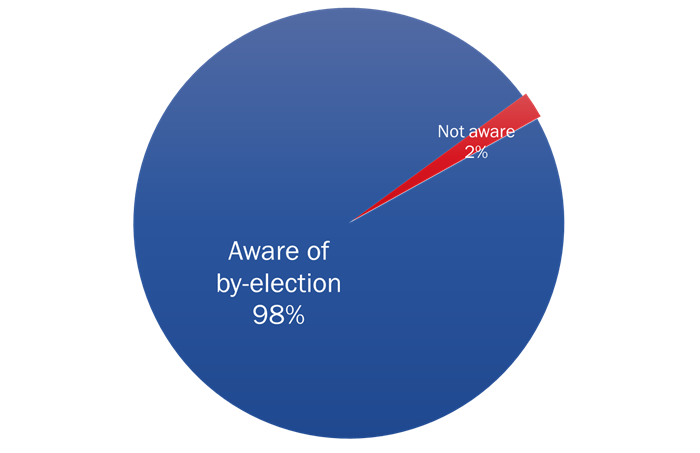
Q1. Did you know that a federal by-election took place on May 6, 2019, in your riding? Base: n=400; all respondents.
Final Report
Prepared for Elections Canada
Supplier Name: Phoenix SPI
Contract Number: 05005-190091-001-CY
Contract Value: $36,458.32 (including HST)
Award Date: 2019-04-25
Delivery Date: 2019-08-14
Registration Number: POR 004-19
For more information on this report, contact Elections Canada at: rop-por@elections.ca.
Survey of Electors Following the May 6, 2019, By-election in Nanaimo–Ladysmith (British Columbia)
Final Report
Prepared for Elections Canada
Supplier name: Phoenix Strategic Perspectives Inc.
August 2019
This public opinion research report presents the results of a telephone survey conducted to help evaluate the May 6, 2019, federal by-election in the electoral district of Nanaimo–Ladysmith (British Columbia).
This publication may be reproduced for non-commercial purposes only. Prior written permission must be obtained from Elections Canada. For more information on this report, contact Elections Canada at rop-por@elections.ca.
Catalogue number:
SE3-106/2019E-PDF
International Standard Book Number (ISBN):
978-0-660-31983-4
Related publications (registration number: POR 004-19):
Catalogue number : SE3-106/2019F-PDF (Final report, French)
Numéro international normalisé du livre (ISBN) : 978-0-660-31984-1
© Her Majesty the Queen in Right of Canada, as represented by the Prime Minister of Canada, 2019.
Cette publication est aussi disponible en français sous le titre : Sondage auprès des électeurs à la suite de l’élection partielle du 6 mai 2019 dans Nanaimo—Ladysmith (Colombie-Britannique)
Ninety-eight percent of electors surveyed said that they were aware that a federal by-election took place on May 6, 2019, in Nanaimo–Ladysmith, BC. Awareness of the by-election was higher among electors aged 25 to 34 (100%) compared to electors aged 35 to 54 (96%).

Q1. Did you know that a federal by-election took place on May 6, 2019, in your riding? Base: n=400; all respondents.
A split sample was used to test recall of Elections Canada advertisements for the May 6, 2019, federal by-election. One subset of respondents (n=205) was asked whether they recalled any advertising or communications from Elections Canada about how, when, and where to vote, a standard question used in previous post-electoral phone surveys. The other subset (n=195) was asked whether they recalled any advertising or communications from Elections Canada on social media, when browsing or on a mobile application, on the radio, in a local newspaper or in any other format. Respondents who indicated that they had seen or heard something about how, when, and where to vote through at least one source were coded as having recalled Elections Canada advertising or communications.
In both samples, a majority of electors recalled advertisements (62% and 73%, respectively). However, the second formulation resulted in a higher proportion of respondents expressing recall.
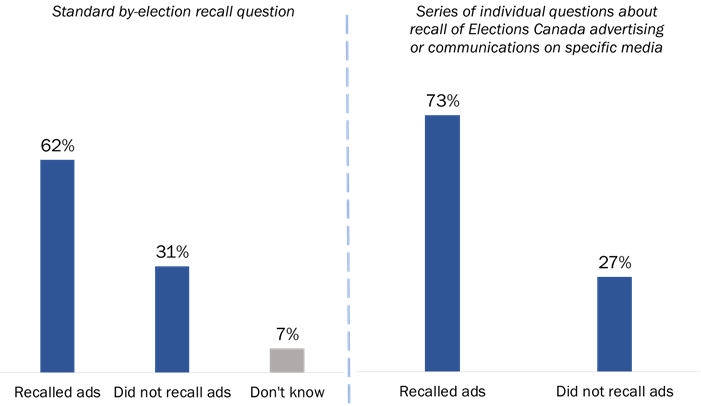
Q29A. During the election period, did you see, hear or read any advertising or communications from Elections Canada about how, when and where to vote in the by-election? Base: n=205; all respondents. SPLIT SAMPLE.
Q30A–E [computed variable]. During the by-election campaign, have you seen or heard communications from Elections Canada about how, when and where to vote in the by-election? Base: n=195; all respondents. SPLIT SAMPLE.
The likelihoodFootnote 1 of recalling any advertising or communications from Elections Canada was higher among:
The subset of respondents from the first split sample who recalled advertising or communications from Elections Canada (n=132) were asked where they saw, heard or read about the May 6, 2019, by-election. These electors mostly recalled the following kinds of advertising or communications from Elections Canada:
Nineteen percent mentioned Facebook, while smaller proportions mentioned television (12%), radio (11%) and political advertising by candidates or parties (10%). Fewer (5% or less) electors recalled Elections Canada advertising through YouTube, word of mouth, Instagram, Twitter, other Internet website or the Elections Canada website.
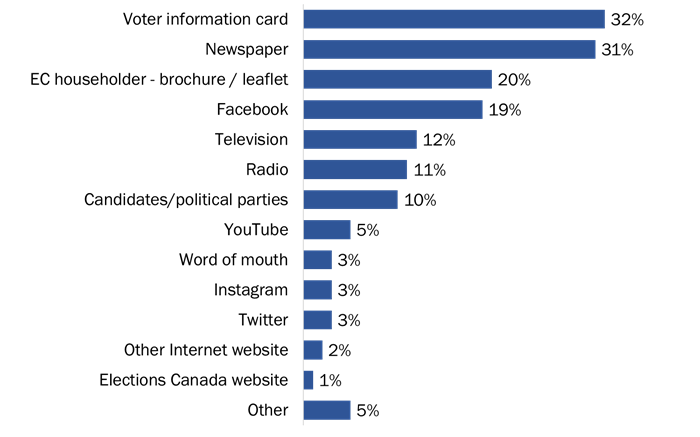
Q29B. Where did you see, hear or read advertising from Elections Canada? Base: n=132; split-sample respondents who recalled communications from EC [Dk/nr: 3%]. (Multiple responses accepted.)
Notable subgroup differences include the following:
As was the case with previous by-election surveys, a number of respondents (12%) said that they recalled seeing Elections Canada ads on television when there were no such ads during the by-election. This recall could be due to several factors, including confusion with other electoral communications, such as partisan advertising, or news reports about the by-election in the riding.
The second subset of respondents (n=195) was asked about specific information sources. These electors were most likely to recall advertising from a local newspaper (34%) or on the radio (31%). Following this, one-quarter recalled advertising when they were browsing or on a mobile application (26%) or on social media (25%).
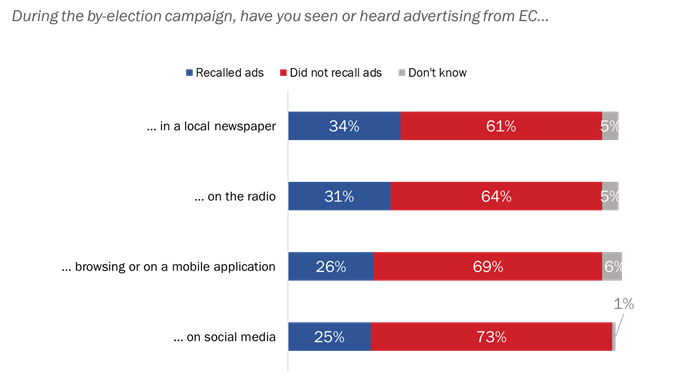
Q30. During the by-election campaign, have you seen or heard advertising from Elections Canada about where, when and how to vote: a) on social media such as Facebook, Twitter or Instagram? / b) when you were browsing or on a mobile application? / c) on the radio? / d) in a local newspaper? Base: n=195; all respondents. SPLIT SAMPLE.
Notable subgroup differences include the following:
The vast majority (89%) of respondents aware of the by-election felt informed about how, when and where to vote for the May 6, 2019, federal by-election, with two-thirds (67%) saying that they felt very informed.

Q28. Overall, how well informed did you feel you were about how, when and where to vote? Would you say that you were…? Base: n=392; those aware of the by-election [Dk/nr: 0.4%]
Notable subgroup differences include the following:
Fifteen percent of electors said they visited the Elections Canada website during the campaign. Of those who visited the Elections Canada website, many (88%) were satisfied with the information provided on the website, with half (54%) saying that they were very satisfied.
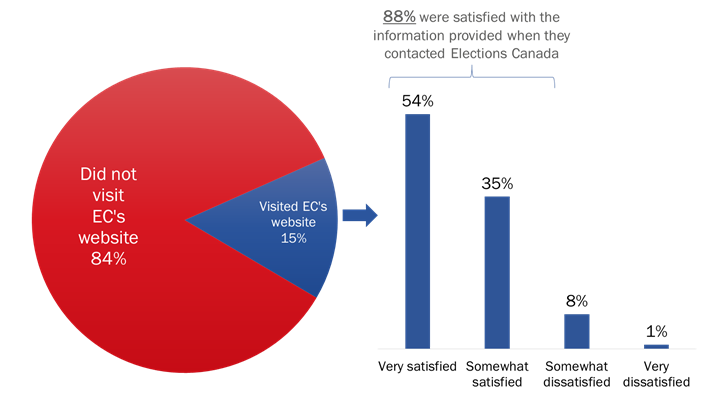
Q31 [LEFT]. Did you visit Elections Canada’s website during the campaign? Base: n=400; all respondents [Dk/nr: 0.4%]
Q32 [RIGHT]. Overall, how satisfied were you with the information on Elections Canada’s website? Would you say that you were…? Base: n=58; all who visited the site. [Dk/nr: 3%]
The likelihood of visiting the Elections Canada website during the campaign was higher among:
Very few (5%) of the electors said they contacted Elections Canada during the campaign. Many (88%) of those who did were satisfied with the information they received, including 47% who were very satisfied.
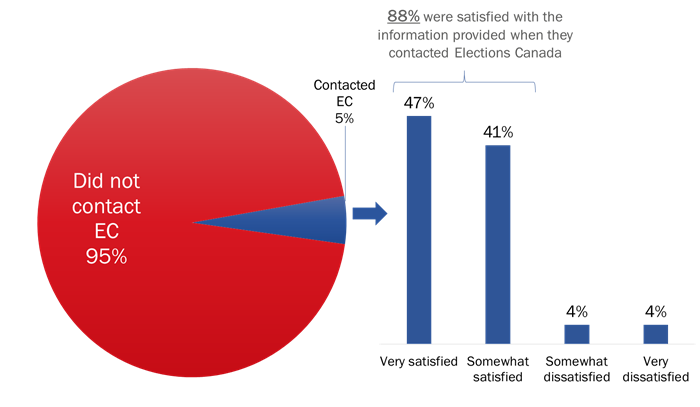
Q33 [LEFT]. Did you contact Elections Canada during the campaign? Base: n=400; all respondents.
Q34 [RIGHT]. Overall, how satisfied were you with the information provided when you contacted Elections Canada? Would you say that you were…? Base: n=21; respondents who contacted EC. [Dk/nr: 4%]
The likelihood of contacting Elections Canada’s during the campaign was higher among:
Approximately 9 in 10 (87%) of those who were aware of the federal by-election said that they received their VIC.
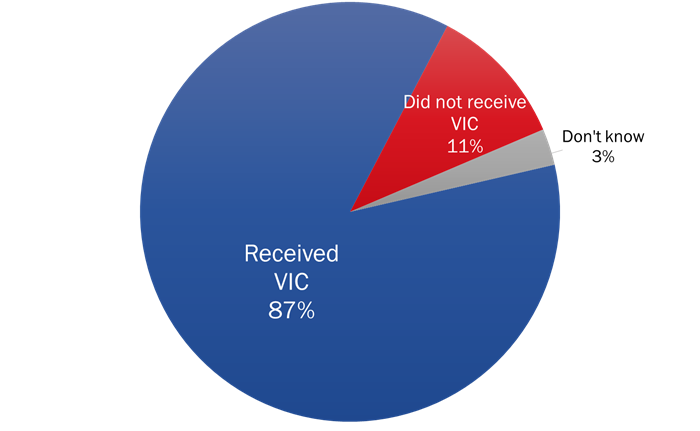
Q4. During the campaign, did you receive a voter information card addressed to you personally and telling you where and when to vote? Base: n=392; those who said they were aware of the by-election.
The following groups of electors were more likely to say that they received a VIC:
Nearly all electors who received a VIC reported that it had the correct name (98%) and address (99%).
Nearly 9 in 10 electors (87%) who voted at a local Elections Canada office, advance poll or polling station on election day said they brought their VIC with them.
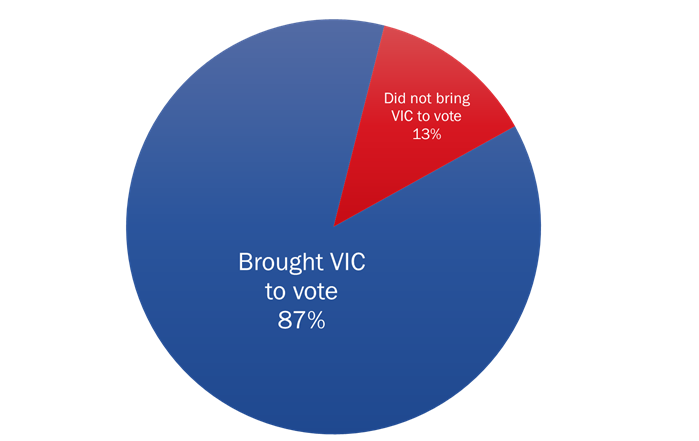
Q21. Did you bring your voter information card with you to the polling station/advance polling station/local Elections Canada office? Base: n=271; respondents who voted at an advance poll or at a polling station on election day.
Q21. Did you bring your voter information card with you to the polling station/advance polling station/local Elections Canada office? Base: n=271; respondents who voted at an advance poll or at a polling station on election day.
There were no significant subgroup differences.
Seven in 10 electors who did not receive a VIC during the campaign did nothing to find out whether they were registered to vote in the federal by-election. Electors who took action to find out whether they were registered did so by finding out at the polling station or local Elections Canada office (8%), using the Online Voter Registration Service on the website (8%) or consulting the Elections Canada website (6%).
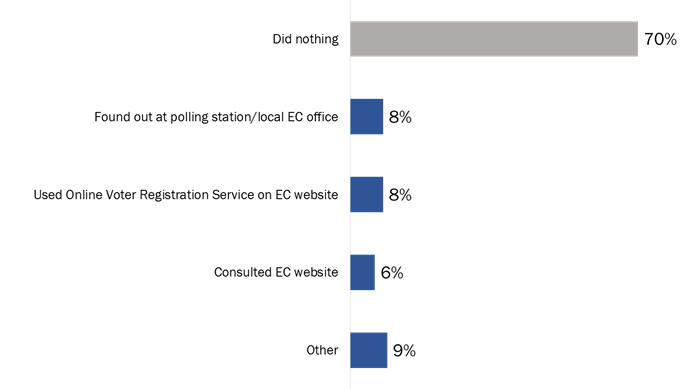
Q7: What did you do to find out whether you were registered to vote in this by-election? Base: n=40; respondents who did not receive a VIC [Dk/nr: 7%]
There were no significant subgroup differences.
Six in 10 electors (61%) said they knew that they need to be registered in order to vote in a Canadian federal election. One-quarter (24%) said they did not need to be registered and 15% were unsure.
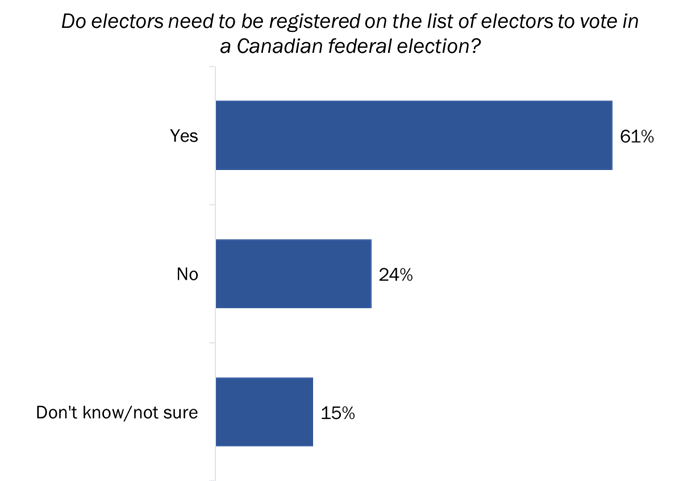
Q8. To the best of your knowledge, do electors need to be registered on the list of electors to vote in a Canadian federal election? Base: n=400; all respondents
The likelihood of knowing that electors need to be registered on the list of electors to vote in a Canadian federal election was higher among electors who received a VIC (64%) compared to those who did not (37%).
The following groups of electors were more likely to say they “did not know” whether electors need to be registered:
In addition, the likelihood of incorrectly answering “No” to this question was higher among:
Nearly seven in 10 (68%) were aware that electors can register at the polling place and then vote immediately afterwards. In contrast, few (8%) were not aware that this is possible, and one-quarter (24%) said that they did not know one way or the other.
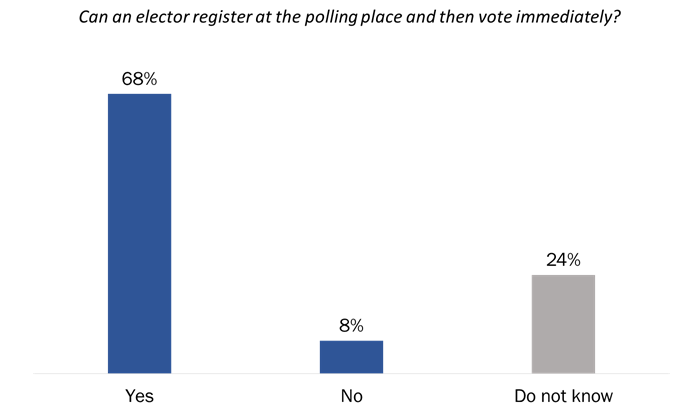
Q9AB. Electors must be registered to vote in a federal election. If an elector is not registered on election day and wants to vote, can they register at the polling place and then vote immediately after? Base: n=400; all respondents.
Notable subgroup differences include the following:
A split sample was used to test awareness of online voter registration.Footnote 2 Half the respondents (n=183) were asked whether electors could use an “online voter registration service on Elections Canada’s website,” a question previously used in post-electoral phone surveys. As this question has always yielded a high proportion of “don’t know” responses from electors, a simplified formulation was developed and asked of the other half (n=217) of the sample (see precise wording of questions in the graph below).

Q10A [LEFT]. To the best of your knowledge, could electors use an Online Voter Registration Service on Elections Canada’s website to check, update or complete their voter registration during the last by-election? Base: n=183; all respondents. SPLIT SAMPLE.
Q10B [RIGHT]. To the best of your knowledge, is it possible for Canadian electors to check, update or complete their voter registration on Elections Canada’s website? Base: n=217; SPLIT SAMPLE.
The results of this split-sample test confirm that the second formulation of the question is easier to understand as it resulted in a smaller proportion of respondents who indicated that they did not know.
Regardless of question formulation:Footnote 3
Seven in 10 (69%) electors who were aware of the by-election held on May 6, 2019, in Nanaimo–Ladysmith, BC said they voted in it.
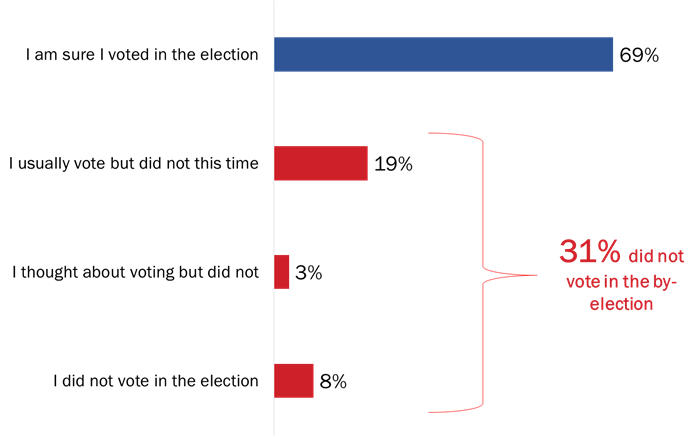
Q2. Which of the following statements describes you? Base: n=392; those who said they were aware of the by-election.
The likelihood of voting was higher among:
Among respondents who said they did not vote in the by-election (n=109), half (49%) said that they did not vote due to everyday life and health reasons. In addition, one-quarter (24%) reported not voting due to political reasons and 6% for reasons related to the electoral process. The “Other reasons” category included not arriving in time, moving out of the riding, the federal general election this year (i.e. will vote then, so there is no need to do so now) and a family emergency, among others.

Q3:. What is the main reason you did not vote? Base: n=109; respondents who did not vote [excludes Dk/nr: 3%].
The table below provides a detailed breakdown of the reasons why respondents did not vote during the May 6, 2019, federal by-election.
| Reasons for Not Voting | % |
|---|---|
| Everyday life or health reasons | 49 |
| Too busy | 21 |
| Out of town | 14 |
| Illness or disability | 14 |
| Political reasons | 24 |
| Not interested in politics | 10 |
| Felt voting would not make a difference | 6 |
| Did not like candidates/parties/campaign | 5 |
| Lack of information about campaign issues and parties’ positions | 3 |
| Did not know whom to vote for | 1 |
| Could not prove identity or address | 1 |
| Electoral process–related reasons | 6 |
| Issues with VIC | 3 |
| Transportation problem/polling station too far | 2 |
| Lack of information about voting process (e.g. when/where to vote) | 1 |
| Other reasons | 17 |
| Forgot to vote | 6 |
| Federal general election coming | 3 |
| Other reasons | 8 |
Those who felt uninformed (30%) about how, when and where to vote were more likely to say that they did not vote in this by-election due to illness or disability than those who were informed (7%).
Half the respondents who said that they were out of town (n=17)Footnote 4 during the election were away due to work commitments (49%), while almost 31% were away for personal reasons. The majority (82%) of those who were out of town during the election had previously planned their trip.
Of the respondents who were too busy to vote (n=25), 4 in 10 said they simply had other priorities that day. Three in 10 had unexpected plans that deterred them from voting, and 7% said that they do not have time in their daily schedule to vote.
A split sample was used to test questions designed to measure electors’ knowledge of current voting methods. One sample of respondents (n=209; split sample 1) was asked, in an open-ended manner, to identify the current ways that electors can vote in a federal election. The other sample (n=191; split sample 2) was asked a set of two questions. First, they were asked how someone can vote in a federal election, and then they were asked whether there are ways to cast a ballot ahead of time (see precise wording of questions in the graph below).
As the graph below indicates, both formulations yielded similar results overall. The one noteworthy difference is that the second formulation resulted in a higher proportion of respondents saying they do not know (specifically, 8% responded this way to the first question in the set and 14% to the second question).
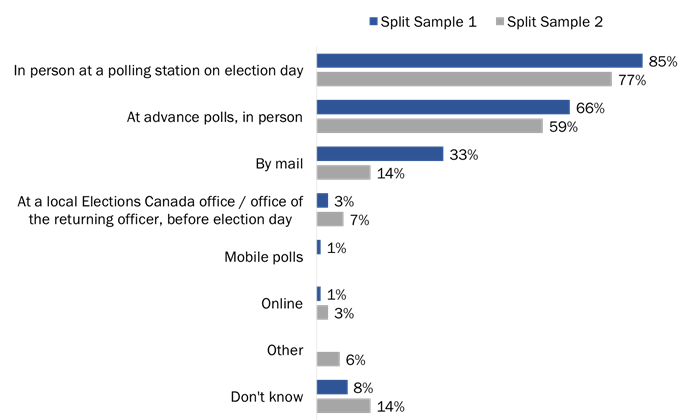
Q11A. To the best of your knowledge, what are the current ways that electors can vote in a federal election? (Multiple responses accepted.)
Base: n=209; SPLIT SAMPLE 1.
Q11B/C. If someone wants to vote in a federal election, how can they do so? Anything else? / Now let’s say someone wants to vote but is not available on election day, are there ways to cast a ballot ahead of time? IF SOMEONE JUST SAYS “Yes,” ASK, “OK, how would you do that?” (Multiple responses accepted.) Base: n=191; SPLIT SAMPLE 2.
Notable subgroup differences include the following:Footnote 5
Three-quarters (74%) of electors who said they voted in the by-election reported doing so at a polling station on election day, while one-quarter (24%) reported going to an advance polling station to vote. Very few reported voting at a local Elections Canada office (2%) or at home (0.4%).
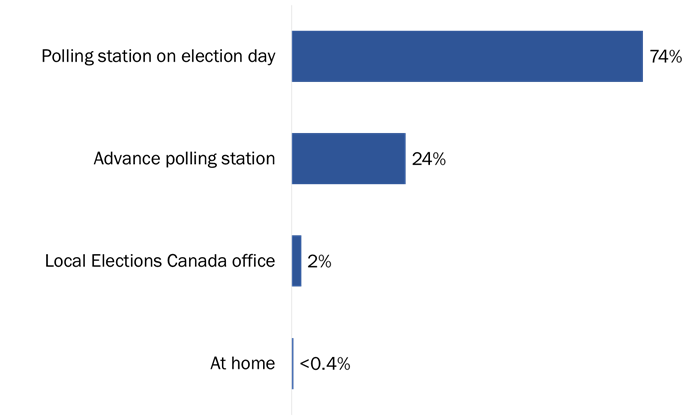
Q12. Which method did you use to vote? Was it …? Base: n=282; all respondents who voted.
Electors who voted on election day were more likely to be:
Electors who voted at an advance polling station were more likely to be:
A split-sample approach was used to measure awareness of identification requirements for voting. Traditionally, post-electoral surveys ask respondents whether they need proof of identity to vote, and then the question is repeated for proof of address. In previous post-electoral surveys, this formulation resulted in very high awareness levels for both requirements. However, survey pre-tests suggested that some respondents did not perceive a difference between the two (i.e. between proof of address and proof of identity). Thus, a second version of this question was developed, asking respondents whether, to the best of their knowledge, electors need proof of identity, proof of address, both or none. The two formulations were compared using the aforementioned split-sample experiment.
As has been the case with previous surveys, the first formulation found that the vast majority of respondents think that electors have to present proof of identity (96%) or proof of address (88%) in order to vote in a Canadian election. Of those asked the second formulation, 86% correctly responded that proof of both identity and address are required to vote in a Canadian federal election. Nine percent indicated that only proof of identity was needed and 1% that neither was needed.
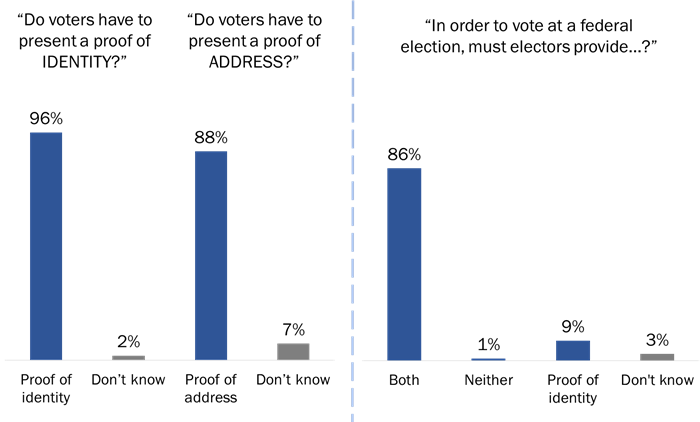
Q14B [LEFT]. Do voters have to present a proof of IDENTITY in order to vote in a Canadian federal election? SPLIT SAMPLE: n=214.
Q15 [LEFT]. Do voters have to present a proof of ADDRESS in order to vote in a Canadian federal election? SPLIT SAMPLE: n=214.
Q14A [RIGHT]. In order to vote at a federal election, must electors provide …? SPLIT SAMPLE: n=186.
The results of this split-sample test confirm those of the results of the five previous by-election surveys.Footnote 6 Furthermore, these results confirm that the new formulation leads to results that better reflect the respondents’ grasp of identification requirements.
The likelihood of saying that electors must provide proof of both identity and address was higher among those who voted at an advance polling station (95%) than those who voted at a polling station on election day (87%).Footnote 7
Virtually all respondents who voted in the by-election found it easy to meet the identification requirements, with the vast majority (92%) describing it as very easy.
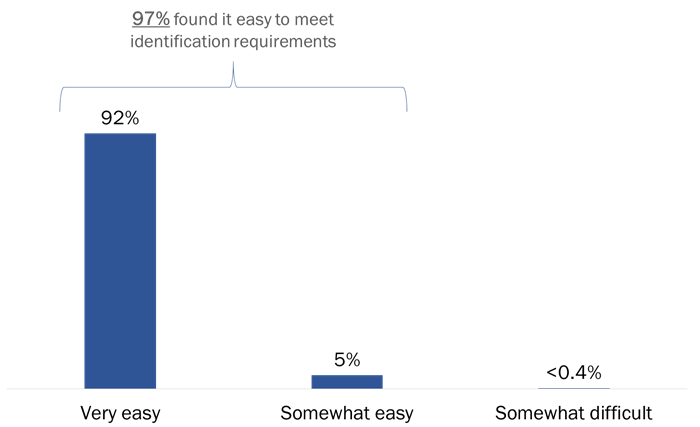
Q16. Overall, how easy was it to meet the identification requirements? Would you say that it was …? Base: n=281; respondents who voted at an advance poll, at a polling station on election day or an EC office [Dk/nr: 2%].
The likelihood of saying that it was very easy to meet the identification requirements was higher among women (96%) than men (88%).
A total of 95% of respondents who voted in the by-election said that it was at least somewhat easy to vote, including 88% who said that it was very easy.

Q13. Overall, how easy was it to vote? Would you say it was …? Base: n=282; respondents who voted and identified a voting method.
[Dk/nr: 1%].
As is the case with previous by-election surveys, nearly everyone surveyed who voted in the by‑election said the polling station, advance polling station or Elections Canada office was a convenient distance from their home (96%), the facility was suitable (95%) and there were enough signs in the facility to help them find where to go to vote (94%).
The likelihood of saying that the building where electors voted was very suitable was higher among those who voted at a polling station on election day (88%) than those who voted at an advance polling station (71%).
Of all voters surveyed (n=276), 76% reported voting between noon and 8:30 p.m.
Of the voters who voted on election day (n=207), one-quarter (27%) reported doing so in the morning (from when the polls open until noon), one-third (32%) said they voted in the afternoon (between noon and 4 p.m.) and 40% claimed to have voted in the evening (from 4 p.m. until the close of polls).
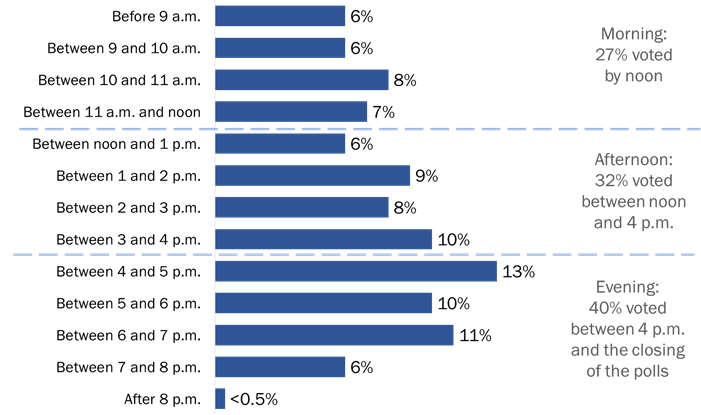
Q22. Do you remember approximately what time it was when you went to vote? Base: n=207; respondents who voted on election day [Dk/nr: 2%].
*Election day polls hours: 8:30 a.m. to 8:30 p.m.
**Percentages may not add up to 100% due to rounding.
Fifty-eight percent of those who voted at an advance polling station (n=69) on April 26, 27, 28 and 29, 2019, reported doing so in the afternoon (between noon and 4 p.m.). The single greatest proportion of these voters (25%) said they voted between noon and 1 p.m.

Q22. Do you remember approximately what time it was when you went to vote? Base: n=69; respondents who voted at an advance poll [Dk/nr: 10%].
*Advance polling stations were open from 12 p.m. to 8 p.m. on April 26, 27, 28 and 29, 2019.
Nearly 6 in 10 (57%) respondents who voted in the by-election said that voting took them five minutes or less, with most of the rest saying that it took them somewhere between 6 and 15 minutes.
Among those who voted at an advance polling station, 36% said that it took them less than five minutes to vote. In comparison, 63% of those who voted on election day indicated that it took them less than five minutes to vote.
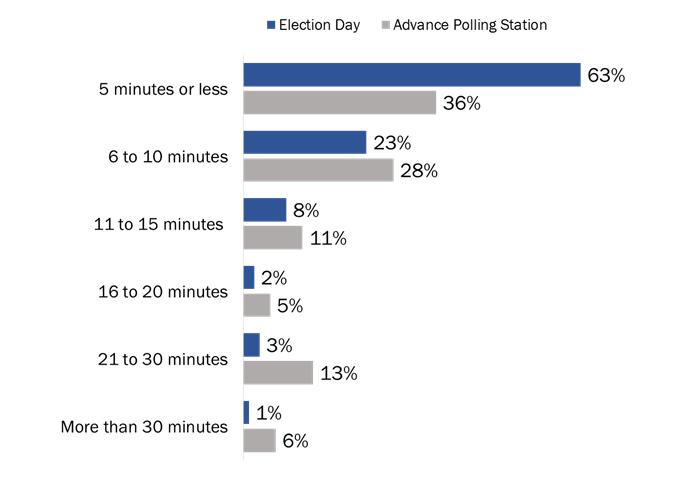
Q23. To the best of your knowledge, how long did it take you to vote at the polling station/advance polling station/local Elections Canada office? This does not include travel time. Base: n= 277; respondents who voted at an advance poll or at a polling station on election day and recalled the time of day they voted.
Virtually all (95%) voters found the time taken to vote to be reasonable. Those who took five minutes or less to vote were more likely to have voted at a polling station on election day (63%) than at an advance polling station (36%).
Of those who voted in the by-election, 96% were satisfied with the services provided by Elections Canada staff, with 90% saying that they were very satisfied.
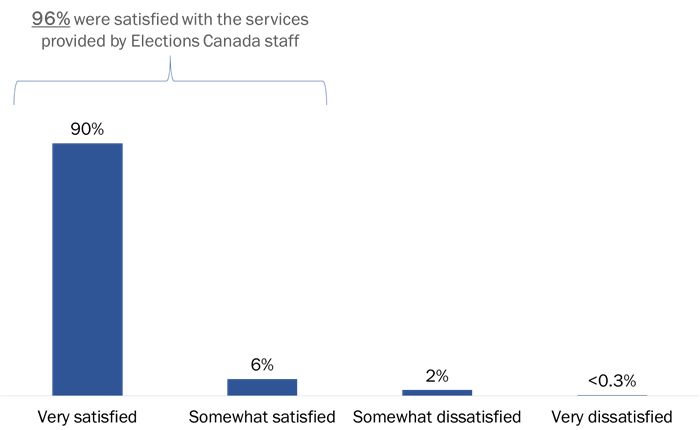
Q27. Overall, how satisfied were you with the services provided by Elections Canada staff when you voted? Would you say they were …? Base: n= 281; respondents who voted at an advance poll, at a polling station on election day or an EC office [Dk/nr: 1%].
There were no notable subgroup differences.
Virtually all voters chose to be served in English (96%), while 3% chose to be served in both official languages. All voters were satisfied with the service they received in their chosen official language.
Nearly all respondents who voted in the by-election (98%) were satisfied with their overall voting experience, with 81% saying that they were very satisfied.
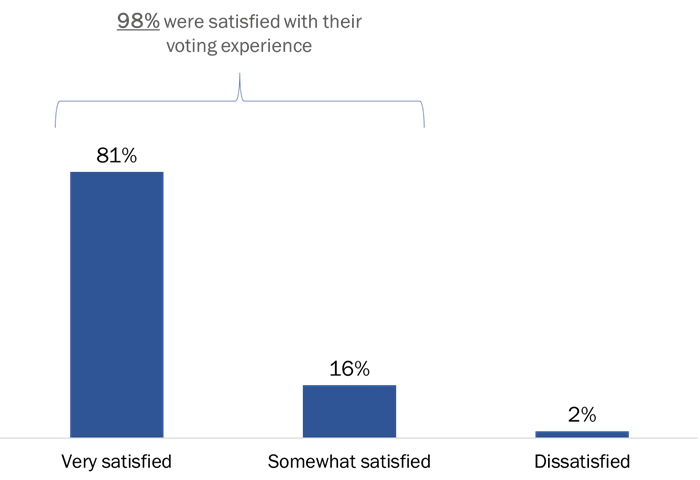
Q35. Overall, how satisfied were you with your voting experience? Would you say that you were …? Base: n=282; all respondents who voted [Dk/nr: 1%].
The following subgroups were more likely to be very satisfied with their voting experience:
Two variations of a question about the fairness with which Elections Canada runs federal by‑elections were asked of respondents. One-half (n=184) was asked the following question: “Thinking about the May 6, 2019, federal by-election, would you say that Elections Canada ran the election …?” The other half (n=216) was asked, “Thinking about federal by-elections in general, would you say that Elections Canada runs elections …?”
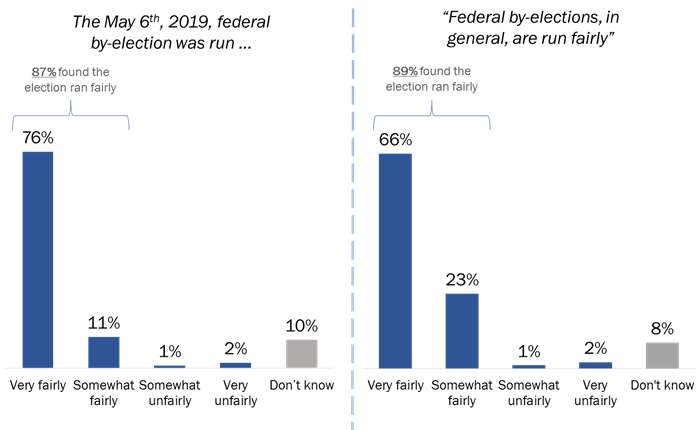
Q36A [LEFT]. Thinking about the May 6, 2019, federal by-election, would you say that Elections Canada ran the election …? Base: n=184. SPLIT SAMPLE.
Q36B [RIGHT]. Thinking about federal by-elections in general, would you say that Elections Canada runs elections …? Base: n=216. SPLIT SAMPLE.
*Percentages may not add up to 100% due to rounding.
The more specific formulation (i.e. focusing on the specific by-election) found the majority of respondents (87%) thought that Elections Canada ran the election fairly, with 76% saying very fairly. The more general formulation yielded similar results overall, with the majority (89%) saying that Elections Canada runs elections fairly. Fewer respondents, however, reported that Elections Canada runs elections very fairly (66% versus 76% of those who responded to the specific formulation). This is the first time that this effect has been evident. In previous post-by‑election surveysFootnote 8 where this split-sample test was conducted, the only noteworthy effect was that the more general formulation resulted in a noticeably lower proportion of electors saying that they did not know.
Regardless of formulation, the following subgroups were more likely to think that the by-election was run very fairly:
A split-sample approach was also used to survey respondents about trust in the accuracy of the by-election results. As in previous waves of the survey, respondents were asked, “What level of trust do you have in the accuracy of the election results in your riding?” In the current wave of the survey, a subset of respondents (n=185) was asked a similar question: “What level of trust do you have in the accuracy of the election results?,” but it was prefaced by the following preamble: “At the end of a federal election, poll workers in each riding count ballots by hand and report the results to Elections Canada.”
As the accompanying graph indicates, both formulations of the question yielded similar overall results. However, respondents who were asked the question without the preamble, and with “your riding” explicitly identified, were more likely to express a very high level of trust (65%) than those who were asked the version prefaced by the preamble but without “your riding” explicitly identified (58%). This result is consistent with the results from previous by-elections.
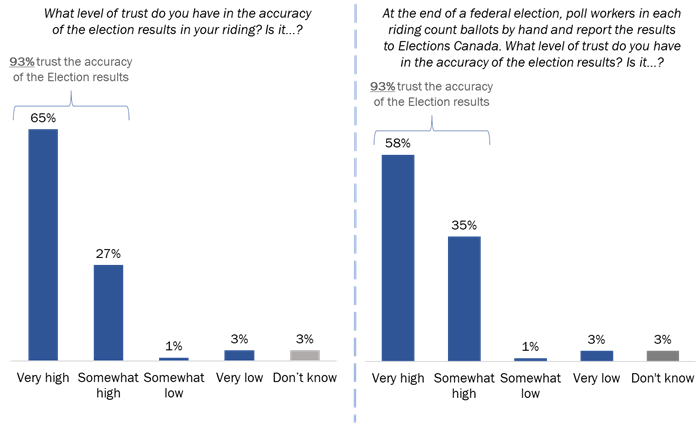
Q37A [LEFT]. What level of trust do you have in the accuracy of the election results in your riding? Is it …? Base: n=185; all respondents. SPLIT SAMPLE.
Q37B [RIGHT]. At the end of a federal election, poll workers in each riding count ballots by hand and report the results to Elections Canada. What level of trust do you have in the accuracy of the election results? Is it …? Base: n=215. SPLIT SAMPLE.
The following subgroups were less likely to trust the accuracy of the election results:Footnote 9
The following subgroups were more likely to have a very high level of trust in the accuracy of the election results:
| Age | Weighted | Unweighted | ||
|---|---|---|---|---|
| n | % | n | % | |
| 18 to 24 | 37 | 9 | 26 | 7 |
| 25 to 34 | 55 | 14 | 23 | 6 |
| 35 to 54 | 101 | 26 | 104 | 27 |
| 55+ | 199 | 51 | 236 | 61 |
| Refused* excluded from % column | 8 | 2 | 11 | 3 |
| Gender | Weighted | Unweighted | ||
|---|---|---|---|---|
| n | % | n | % | |
| Male | 191 | 48 | 196 | 49 |
| Female | 207 | 52 | 202 | 51 |
| Non-binary/trans | 1 | 0.3 | 1 | 0.3 |
| Refused* excluded from % column | 1 | 0.3 | 1 | 0.3 |
| Employment Status | Weighted | Unweighted | ||
|---|---|---|---|---|
| n | % | n | % | |
| Employed | 214 | 52 | 193 | 47 |
| Retired | 128 | 32 | 156 | 39 |
| Student | 10 | 3 | 5 | 1 |
| Unemployed and looking for work | 29 | 7 | 25 | 6 |
| Homemaker | 4 | 1 | 4 | 1 |
| Permanently unable to work | 12 | 3 | 12 | 3 |
| Temporarily not working | 2 | 1 | 2 | 1 |
| Retired and working | 9 | 2 | 10 | 2 |
| Other | 2 | 1 | 2 | 1 |
| Education | Weighted | Unweighted | ||
|---|---|---|---|---|
| n | % | n | % | |
| Less than high school | 5 | 1 | 4 | 1 |
| Some high school | 17 | 4 | 17 | 4 |
| Completed high school | 79 | 20 | 80 | 20 |
| Some college | 40 | 10 | 38 | 10 |
| Completed college | 70 | 17 | 74 | 19 |
| Some university | 37 | 9 | 38 | 10 |
| Completed university | 103 | 26 | 99 | 25 |
| Post-graduate university | 49 | 12 | 49 | 12 |
| Don’t know | 1 | 0.2 | 1 | 0.2 |
| Household Income | Weighted | Unweighted | ||
|---|---|---|---|---|
| n | % | n | % | |
| Below $30,000 | 47 | 12 | 43 | 11 |
| $30,000 to just under $60,000 | 75 | 19 | 77 | 19 |
| $60,000 to just under $90,000 | 70 | 17 | 75 | 19 |
| $90,000 to just under $110,000 | 44 | 11 | 39 | 10 |
| $110,000 and over | 97 | 24 | 95 | 24 |
| Don’t know | 30 | 8 | 26 | 7 |
| I prefer not to answer | 38 | 10 | 45 | 11 |
Probability sampling was undertaken using random digit dialling. To ensure that the sample was representative, and that the results reflected the distribution of electors by age and gender, the sample frame was based on Statistics Canada census data. Respondents were randomly selected using cellphone and landline samples in an effort to reach younger electors and to ensure that cellphone-only households were included in the sampling frame. The landline sample was supplied by ASDE. The cellphone sample was supplied by Advanis (the firm responsible for data collection for this survey, under subcontract to Phoenix SPI).
The same random-selection process was used for both the landline and cellphone samples. In terms of the specific respondent in the household, interviewers asked to speak to an individual, 18 years of age and older, or a person in the household who had the most recent birthday. If that was not the initial individual answering the telephone, but another in the household, interviewers asked to speak to the eligible respondent. No selection procedures were used for the cellphone sample.
Once an appropriate adult was reached, voter eligibility was verified by the interviewer. To be eligible for the survey, respondents had to be Canadian citizens, at least 18 years of age on polling day and whose address of ordinary residence was in the electoral district from the first day of the revision period until election day.
To pre-test the questionnaire, respondents were first administered the survey and then asked a series of short, follow-up questions. The debriefing following the survey provided an opportunity for respondents to offer feedback on the questionnaire. The follow-up questions were:
In total, 10 pre-test interviews were conducted by telephone on May 7, 2019. Respondents had the choice of participating in the official language of their choice. In total, 10 pre-test interviews were completed in English. The pre-test interviews were digitally recorded and reviewed by Phoenix SPI team members and Elections Canada officials.
Overall, the questionnaire worked well, as was expected given that it has been administered following previous by-elections.All fieldwork was conducted using computer-assisted telephone interviewing technology. In an effort to minimize non-response bias, those who declined to complete the survey over the telephone were given the option to complete the survey online. Five respondents agreed to complete the survey online after having their voter eligibility verified by the interviewer. However, none of them completed the online version. In total, 400 electors were interviewed by telephone. Based on a sample of this size, the overall results can be considered accurate to within ±4.9%, 19 times out of 20.
The following specifications applied:
The data collection was conducted in accordance with the standards set out by industry associations as well as applicable federal legislation, including the Personal Information Protection and Electronic Documents Act, Canada’s private-sector privacy law.
The following table presents information about the final call dispositions for this survey and calculation of the response rate:
| Landline | Cell | Total | |
|---|---|---|---|
| Total Numbers Attempted | 5,539 | 5,458 | 10,997 |
| Out of scope – Invalid | 1,360 | 266 | 1,626 |
| Unresolved (U) | 2,675 | 3,822 | 6,497 |
| No answer/Answering machine | 2,675 | 3,822 | 6,497 |
| In scope – Non-responding (IS) | 1,053 | 873 | 1,926 |
| Language barrier/illness/incapable | 17 | 12 | 29 |
| Callback (respondent not available) | 6 | 1 | 7 |
| Refusal (household) | 671 | 511 | 1,182 |
| Refusal (respondent) | 359 | 349 | 708 |
| In scope – Responding units (R) | 451 | 497 | 948 |
| Completed interview | 201 | 199 | 400 |
| Terminate quota filled | 13 | 2 | 15 |
| NQ – Does not qualify | 230 | 144 | 374 |
| NQ – Citizenship | 0 | 2 | 2 |
| NQ – Age | 0 | 0 | 0 |
| NQ – Not in riding | 7 | 150 | 157 |
| Response rate | 10.8% | 9.6% | 10.1% |
The response rate formula is calculated as follows: [R=R/(U+IS+R)]. This means that the response rate is calculated as the number of responding units [R] divided by the number of unresolved [U] numbers plus in-scope [IS] non-responding households and individuals plus responding units [R].
To produce population estimates, the survey data were weighted to accurately reflect the age and gender distribution of eligible electors in the federal ridings. Specifically, the nested census populations of men and women residing in the district who were 18–24, 25–34, 35–44, 45–64, and 65 or older (at the time of the research) were compiled as the weighting frame. The survey results were then compared to the same age and gender proportions to generate the survey weights. Any respondents who refused to provide their age were given a neutral weight so as not to skew the weighting proportions. Weights were based on 2016 Statistics Canada census data.
The table below shows the unweighted and weighted proportions for the variables used to create the weights:
| Unweighted | Weighted | |
|---|---|---|
| Base | n=400 | n=400 |
| Gender | ||
| Male | 49% | 52% |
| Female | 51% | 48% |
| Age | ||
| 18 to 24 | 7% | 9% |
| 25 to 34 | 6% | 14% |
| 35 to 44 | 13% | 13% |
| 45 to 64 | 39% | 36% |
| 65 or older | 36% | 28% |
Telephone surveys of the Canadian public often under-represent younger Canadians and overrepresent older Canadians. Previous by-election surveys have resulted in few 18-to-32-year-old electors in the final survey sample. To address this, the composition of the sample frame was adjusted to include a larger proportion of cellphones (because research shows that younger Canadians are more likely to be reached on cellphones than on landlines).
PINTRO
PHONE INTRO
Good afternoon/evening. My name is … and I am calling from […], a public opinion research company. Today we are conducting a study on behalf of Elections Canada. Please be assured that we are not selling or soliciting anything.
[IF ASKED]: The survey will take about 12 minutes to complete.
[IF ASKED ABOUT THE LEGITIMACY OF THE SURVEY]: If you would like to ensure that this survey is run by Elections Canada, you can call their toll-free number at 1-800-463-6868. Their hours of operation are Monday to Friday, from 9:00 a.m. to 5:00 p.m. (Eastern Time).
You can also contact Alethea Woods, from Phoenix Strategic Perspectives, at 613-260-1700, ext. 223.
[IF ASKED ABOUT THE NATIONAL DO NOT CALL LIST]: Calls made for the purpose of market research, polls or surveys are not considered telemarketing calls. Organizations making these types of calls are not required to register with the National Do Not Call List. The National Do Not Call List toll-free telephone number is 1-866-580-3625.
[IF ASKED ABOUT ELECTIONS CANADA]: The toll-free telephone number for Elections Canada is 1-800-463-6868. Their hours of operation are Monday to Friday, from 9:00 a.m. to 5:00 p.m. (Eastern Time).
A. LANDLINE PROTOCOL
I would like to speak to the person in your household who is a Canadian citizen, is at least 18 years old and who has had the most recent birthday. Would that be you?
IF PERSON SELECTED IS NOT AVAILABLE, ARRANGE FOR CALLBACK.
IF PERSON SELECTED IS NOT AVAILABLE OVER INTERVIEW PERIOD, ASK FOR PERSON WITH NEXT MOST RECENT BIRTHDAY AND GO TO SCR1.
IF IN DOUBT, CONFIRM WHETHER RESPONDENT WOULD LIKE TO BE INTERVIEWED IN ENGLISH OR FRENCH.
PRIV
Please note that this call may be recorded for quality control or training purposes and all personal information collected will be held in strict confidence. Responses are used only for research and statistical purposes. The anonymized database of all responses may be shared with researchers who collaborate with Elections Canada.
SCR1
May I confirm that you are a Canadian citizen?
IF NO: This survey must be completed by Canadian citizens. Would there be someone in your household who is a Canadian citizen? IF YES, ASK TO SPEAK TO THAT PERSON.
01 Yes
02 No GO TO THNK2
SCR2
May I confirm that you were at least 18 years old on May 6, 2019?
IF NO: This survey must be completed by Canadian citizens who were at least 18 years old on May 6, 2019. Would there be someone in your household who was at least 18 years old on May 6, 2019? IF YES, ASK TO SPEAK TO THAT PERSON.
01 Yes
02 No GO TO THNK2
SCR3 age
In what year were you born?
01 ___________
00 Don’t know/Refusal
SCR3B check eligibility 2015
SCR3 IS 1997
In what month and on what day were you born?
IF ASKED WHY: This is to verify whether you were eligible to vote in a federal election prior to the May 6, 2019, by-election.
RECORD THE TWO ANSWERS
SCR3 = Month: __________
SCR3A = Day: ____________
00 Don’t know/Refusal
SCR4 residence
Between March 27 and May 6, 2019, did you live in the federal riding of NANAIMO–LADYSMITH?
IF NO: Unfortunately, this survey must be completed by Canadian citizens who lived in this riding and were eligible to vote in the May 6, 2019, by-election. THANK AND DISCONTINUE.
IF ANSWERS SPONTANEOUSLY THAT LIVED IN RIDING FOR ONLY PART OF REVISION PERIOD: Unfortunately, this survey must be completed by Canadian citizens who lived in this riding for the entire revision period (March 27 through May 6, 2019) and were eligible to vote in the May 6, 2019, by‑election. THANK AND DISCONTINUE.
IF UNSURE: REVIEW LIST OF COMMUNITIES IN THE RIDING WITH RESPONDENT TO DETERMINE WHETHER HE/SHE WAS A RESIDENT OF THE RIDING. IF SO, CONTINUE. IF NOT, DISCONTINUE USING LANGUAGE IN CODE 02. LIST OF COMMUNITIES ATTACHED.
IF UNSURE (2): INTERVIEWER TO USE ELECTIONS CANADA’S ONLINE VOTER INFORMATION SERVICE TO VERIFY RIDING BY POSTAL CODE (http://www.elections.ca/scripts/vis/finded).
01 Yes
02 No GO TO THNK2
B. CELL PROTOCOL
I would like to speak to someone who is a Canadian citizen and is at least 18 years old. Does that describe you?
IF PERSON IS NOT AVAILABLE, ARRANGE FOR CALLBACK.
IF PERSON IS NOT AVAILABLE OVER INTERVIEW PERIOD, THANK AND DISCONTINUE.
IF IN DOUBT, CONFIRM WHETHER RESPONDENT WOULD LIKE TO BE INTERVIEWED IN ENGLISH OR FRENCH.
PRIV
Thank you. Please note that this call may be recorded for quality control or training purposes and all personal information collected will be held in strict confidence. Responses are used only for statistical purposes.
SCR1
May I confirm that you are a Canadian citizen?
IF NO: This survey must be completed by Canadian citizens. THANK AND DISCONTINUE.
01 Yes
02 No GO TO THNK2
SCR2
May I confirm that you were at least 18 years old on May 6, 2019?
IF NO: This survey must be completed by Canadian citizens who were at least 18 years old on May 6, 2019. THANK AND DISCONTINUE.
01 Yes
02 No GO TO THNK2
SCR3 age
In what year were you born?
01 ___________
00 Don’t know/Refusal
SCR3B check eligibility 2015
SCR3 IS 1997
In what month and on what day were you born?
IF ASKED WHY: This is to verify whether you were eligible to vote in a federal election prior to the May 6, 2019, by-election.
RECORD THE TWO ANSWERS
SCR3 = Month: __________
SCR3A = Day: ____________
00 Don’t know/Refusal
SCR4 residence
Between March 27 and May 6, 2019, did you live in the federal riding of NANAIMO–LADYSMITH?
IF NO: Unfortunately, this survey must be completed by Canadian citizens who lived in this riding and were eligible to vote in the May 6, 2019, by-election. THANK AND DISCONTINUE.
IF ANSWERS SPONTANEOUSLY THAT LIVED IN RIDING FOR ONLY PART OF REVISION PERIOD: Unfortunately, this survey must be completed by Canadian citizens who lived in this riding for the entire revision period (March 27 through May 6, 2019) and were eligible to vote in the May 6, 2019, by‑election. THANK AND DISCONTINUE.
IF UNSURE: REVIEW LIST OF COMMUNITIES IN THE RIDING WITH RESPONDENT TO DETERMINE WHETHER HE/SHE WAS A RESIDENT OF THE RIDING. IF SO, CONTINUE. IF NOT, DISCONTINUE USING LANGUAGE IN CODE 02. LIST OF COMMUNITIES ATTACHED.
IF UNSURE (2): INTERVIEWER TO USE ELECTIONS CANADA’S ONLINE VOTER INFORMATION SERVICE TO VERIFY RIDING BY POSTAL CODE (http://www.elections.ca/scripts/vis/finded).
01 Yes
02 No GO TO THNK2
Q1 know election
Did you know that a federal by-election took place on May 6, 2019, in your riding?
DO NOT READ
IF NO: Confirm once again whether the respondent was living in the federal district (i.e. not just the city), using the geographic boundary description provided (“map”).
01 Yes
02 No GO TO Q8
98 Don't know GO TO Q8
99 Refusal GO TO Q8
Q2 voted or not
Many people don’t or can’t vote for a variety of reasons. This is particularly true for by‑elections, where voter turnout is often much lower than in general elections. Which of the following statement describes you?
01 I did not vote in the election
02 I thought about voting this time but didn’t vote
03 I usually vote but didn’t this time
04 I am sure I voted in the election
DO NOT READ
98 Don’t know
99 Refusal
Q3 reason no vote
Q2 IS 01 or 02 or 03
What is the main reason you did not vote?
DO NOT READ – CODE 1 ANSWER
Everyday life or health reasons
01 Too busy
02 Out of town
03 Illness or disability
Political reasons
04 Not interested in politics
05 Lack of information about campaign issues and parties’ positions
06 Did not like candidates/parties/campaign
07 Felt voting would not make a difference
08 Did not know who to vote for
Electoral process–related reasons
09 Could not prove identity or address
10 Not on voters list
11 Transportation problem/polling station too far
12 Lack of information about the voting process (e.g. when/where to vote)
13 Lineups were too long
14 Issues with the voter information card
All other reasons
15 Forgot to vote
16 Religious or other beliefs
17 Other reason (specify)
98 Don’t know
99 Refusal
Q3A missing ID
Q3 IS 09 (Failed ID Requirements)
Which pieces of identification or documentation were you missing?
READ IF NECESSARY – CODE UP TO 3 ANSWERS
01 Document with your photo
02 Document with your name
03 Document with your address
04 No identification pieces
77 Other (specify)
DO NOT READ
98 Don’t know
99 Refusal
Q3B out of town
Q3 IS 02 (Out of town)
Were you out of town for work or personal reasons?
01 Work
02 Personal reasons
03 Other (specify)
DO NOT READ
99 Refusal
IF RESPONDENT ASKS WHY
Elections Canada is working to improve its services for electors who are out of town on voting days.
Q3C unplanned
Q3 IS 02 (out of town)
Would you say that your travel was planned or unplanned?
01 Planned
02 Unplanned
DO NOT READ
99 Refusal
IF RESPONDENT ASKS WHAT IS MEANT BY UNPLANNED
This means that the trip was not planned in advance – for example, you knew that you were leaving less than a week before you left.
IF RESPONDENT ASKS WHY WE WANT TO KNOW
Elections Canada is working to improve its services for electors who are out of town on voting days.
Q3D too busy forced choice
IF Q3 IS 01
I noted that you were too busy to vote. If you had to choose, which of the following most closely reflects your situation? Would it be …
READ; ROTATE ITEMS
01 There isn’t time in my normal daily schedule to vote
02 Something unexpected came up and I had to change my plans
03 I had other priorities that day
04 Other [open-ended]
DO NOT READ
99 Refusal
PQ4
I would like to ask a few questions about the information you may have received in advance of the by‑election.
Q4 VIC
During the campaign, did you receive a voter information card addressed to you personally and telling you where and when to vote?
DO NOT READ
01 Yes
02 No
98 Don’t know
99 Refusal
Q5 name on vic
Q4 IS 01
Was your name correct on the card you received?
DO NOT READ
01 Yes
02 No
98 Don’t know
99 Refusal
Q6 address on vic
Q4 IS 01
And was your address correct on the card?
DO NOT READ
01 Yes
02 No
98 Don’t know
99 Refusal
Q7 ensure registration
Q4 IS 02 OR 98 OR 99
What did you do to find out whether you were registered to vote in this by-election?
DO NOT READ. CODE UP TO 3 ANSWERS
INTERVIEWERS: IF RESPONDENT SAYS HE/SHE WENT ONLINE/CHECKED WEBSITE (CODE 04), ALSO PROBE FOR USE OF ONLINE VOTER REGISTRATION SERVICE (CODE 06).
01 Did nothing
02 Found out at the polling station/local Elections Canada office
03 Called 1-800 number of Elections Canada
04 Consulted the Elections Canada website
05 Informed the revising agent who came to my home
06 Used the Online Voter Registration Service on the Elections Canada website
07 Learned from revising agent who came to my home
08 Learned from my voter information card
77 Other (specify)
98 Don't know
99 Refusal
PQ8
Now, I would like to ask you a few questions about voting in the by-election …
Q8 need to be registered
To the best of your knowledge, do electors need to be registered on the list of electors to vote in a Canadian federal election?
IF ASKED: This means that your name is on the list of electors.
DO NOT READ
01 Yes
02 No
98 Don’t know
99 Refusal
Q9A election day registration
IF Q8 IS 01
You are right, electors must be registered to vote in a federal election. If an elector is not registered on election day and wants to vote, can they register at the polling place and then vote immediately after?
DO NOT READ
01 Yes
02 No
98 Don’t know
99 Refusal
Q9B election day registration
IF Q8 IS 02 (No), 98 (Don’t know) OR 99 (Refusal)
Actually, electors do need to be registered to vote in a federal election. If an elector is not registered on election day and wants to vote, can they register at the polling place and then vote immediately after?
DO NOT READ
01 Yes
02 No
98 Don’t know
99 Refusal
Q10
SPLIT SAMPLE 50/50
Q10A register online a
To the best of your knowledge, could electors use an Online Voter Registration Service on Elections Canada’s website to check, update or complete their voter registration during the last by-election?
DO NOT READ
01 Yes
02 No
98 Don’t know
99 Refusal
Q10B register online b
To the best of your knowledge, is it possible for Canadian electors to check, update or complete their voter registration on Elections Canada’s website?
DO NOT READ
01 Yes
02 No
98 Don’t know
99 Refusal
Q11
SPLIT SAMPLE 50/50
Q11 Ways to vote
To the best of your knowledge, what are the current ways that electors can vote in a federal election? DO NOT READ – SELECT ALL THAT APPLY (MULTIPLE MENTIONS). PROBE CAREFULLY TO AVOID SUGGESTING ANSWERS THAT WOULD GIVE AWAY THE LIST. AFTER EACH ANSWER, PROBE “Anything else?”
01 In person at a polling station on election day
02 At advance polls, in person
03 By mail (either within Canada or outside Canada)
04 At a local Elections Canada office/office of the returning officer, before election day
05 At home (for electors with a disability)
06 Mobile polls (including for members of Canadian Forces, prisons, long-term care facilities)
97 Other, please specify
98 Don’t know
99 Refusal
NOTES:
IF RESPONDENT SIMPLY SAYS “POLLING STATION,” PROBE “Could you please be more specific – about when would that be?”
IF RESPONDENT SAYS “PRIOR TO ELECTION DAY,” ASK FOR CLARIFICATION “Could you please be more specific?” AS 02, 03 and 04 CAN BE PRIOR TO ELECTION DAY, SEE CHART.
IF RESPONDENT SAYS “ONLINE,” PROBE TO FIND OUT WHETHER THEY REFER TO CASTING A VOTE ONLINE OR TO ORDERING A BALLOT KIT ONLINE TO VOTE BY MAIL.
IF RESPONDENT ASKS FOR CLARIFICATION REGARDING ANSWER B “AT THE LOCAL ELECTIONS CANADA OFFICE,” say: “Whenever there is an election, the official in charge of conducting the election in a riding opens an office. That office is open to the public for the duration of the campaign. Is it possible to vote there?”
| Ways | When | How |
|---|---|---|
| On election day | On election day (Monday, May 6) | In person, at a polling station |
| Advance polls | A full week before the election, from Friday to Monday | In person, at a polling station |
| By mail | From the day the election is called until the Tuesday before the election | By getting a special ballot kit:
|
| At a local Elections Canada office/office of the returning officer | From the day the election is called until the Tuesday before the election | Electors can vote at any time during the campaign by going to the local Elections Canada office. Common among those who are away for advance polls and polling day. |
| At home | From the day the election is called until the Tuesday before the election | Elections Canada offers voting at home in the presence of an election officer and a witness for voters with a disability or an illness. There are specific circumstances a voter must meet. Uncommon. |
| Mobile polls | From the day the election is called until the Tuesday before the election | Mobile polls are set up with a returning officer to visit electors in difficult-to-reach locations such as Canadian forces bases, prisons, long-term care facilities and very remote communities. |
Q11B Ways to vote
If someone wants to vote in a federal election, how can they do so? Anything else? DO NOT READ – SELECT ALL THAT APPLY (MULTIPLE MENTIONS). IF SOMEONE SAYS, “You go in person/At the polling station,” CODE AS 01 AND ASK Q11C.
01 In person at a polling station on election day
02 At advance polls, in person
03 By mail (either within Canada or outside Canada)
04 At a local Elections Canada office/office of the returning officer, before election day
05 At home (for electors with a disability)
06 Mobile polls (including for members of Canadian Forces, prisons, long-term care facilities)
97 Other, please specify
98 Don’t know
99 Refusal
Q11C: ways to vote 2
Now let’s say someone wants to vote but is not available on election day, are there ways to cast a ballot ahead of time? IF SOMEONE JUST SAYS “Yes,” ASK, “OK, how would you do that?”
02 At advance polls, in person
03 By mail (either within Canada or outside Canada)
04 At a local Elections Canada office/office of the returning officer, before election day
05 At home (for electors with a disability)
06 Mobile polls (including for members of Canadian Forces, prisons, long-term care facilities)
07 No
97 Other, please specify
98 Don’t know
99 Refusal
Q12 where did you vote
Q2 IS 04
Which method did you use to vote? Was it …
READ IN ORDER UNTIL RESPONDENT PROVIDES A RESPONSE – CODE ONE ANSWER ONLY
01 At the polling station on election day on May 6, 2019?
02 At the advance polling station (on April 26, 27, 28 or 29, 2019)?
03 At the local Elections Canada office before election day?
04 By mail?
05 At home (if disabled)?
DO NOT READ
77 Other (specify)
98 Don’t know
99 Refusal
IF RESPONDENT ASKS FOR CLARIFICATION AT ANSWER 03 “AT THE LOCAL ELECTIONS CANADA OFFICE”
Whenever there is an election, the official in charge of conducting the election in a riding opens an office. That office is open to the public for the duration of the campaign. Did you vote there before election day?
IF RESPONDENTS SAY THEY VOTED ONLINE, ASK FOR CLARIFICATION. VOTERS WITH A DISABILITY CAN REGISTER ONLINE TO RECEIVE A BALLOT IN THE MAIL, WHICH CAN BE COMPLETED IN THEIR HOME AND MAILED IN. THESE MENTIONS SHOULD BE CODED AS: 05 – AT HOME.
Q13 easy to vote
Q2 IS 04
Q12 IS NOT 98 or 99
Overall, how easy was it to vote? Would you say it was …?
READ
01 Very easy
02 Somewhat easy
03 Somewhat difficult
04 Very difficult
DO NOT READ
98 Don’t know
99 Refusal
Q14
SPLIT SAMPLE 50/50 BETWEEN Q14A and Q14B+Q15
Q14A proof id address
In order to vote at a federal election, must electors provide …
01 A proof of identity
02 A proof of address
03 Both
04 Neither
DO NOT READ
98 Don’t know
99 Refusal
Q14B proof ID
RANDOM ROTATE Q14B WITH Q15 – PLEASE USE A FLAG VARIABLE FOR IDENTIFICATION OF 1st AND 2nd
To the best of your knowledge, do voters have to present a proof of IDENTITY in order to vote in a Canadian federal election?
DO NOT READ
01 Yes
02 No
98 Don’t know
99 Refusal
Q15 proof address
RANDOM ROTATE Q15 WITH Q14B – PLEASE USE A FLAG VARIABLE FOR IDENTIFICATION OF 1st AND 2nd
To the best of your knowledge, do voters have to present a proof of ADDRESS in order to vote in a Canadian federal election?
DO NOT READ
01 Yes
02 No
98 Don’t know
99 Refusal
Q1 IS 02 OR 98 or 99; GO TO PS1 (SOCIO-DEMOGRAPHIC)
Q12 IS 04, 05, 77, 98 OR 99; GO TO PQ28
Q2 IS 01 or 02 or 03; GO TO PQ28
Q2 IS 04
Q16 easy proof id
Overall, how easy was it to meet the identification requirements? Would you say that it was …?
READ SCALE. NOTE: THIS QUESTION REFERS TO RESPONDENT’S OWN EXPERIENCE.
01 Very easy
02 Somewhat easy
03 Somewhat difficult
04 Very difficult
DO NOT READ
98 Don’t know
99 Refusal
Q17 distance to poll
Was the (answer underlined at Q12: 01 polling station, 02 advance polls, 03 local Elections Canada office) at a convenient distance from your home?
DO NOT READ
01 Yes
02 No
98 Don’t know
99 Refusal
Q18 difficulty reaching building
INSERT BASED ON Q12 RESPONSE OF 1, 2 OR 3
1 = polling station
2 = advance polling stations
3 = local Elections Canada office
Did you have any difficulty reaching the ___________?
DO NOT READ. QUESTION REFERS TO DIFFICULTY GETTING TO THE BUILDING.
01 Yes
02 No
98 Don’t know
99 Refusal
Q18B what was difficult
Q18 IS 01
Could you briefly describe the main difficulty in reaching the (answers underlined at Q12: 01 polling station, 02 advance polling station or 03 local Elections Canada office)?
DO NOT READ – CODE UP TO 3 ANSWERS
01 Physical accessibility
02 Polling station address difficult to find
03 Room inside the building difficult to find
04 Not enough parking
05 Wrong information on my voter information card (i.e. wrong polling station address)
06 Imprecise signage (interior/exterior)
77 Other (specify)
98 Don’t know
99 Refusal
Q19 building adequate
Would you say that the building where you voted was …?
READ SCALE
01 Very suitable
02 Somewhat suitable
03 Not very suitable
04 Not suitable at all
DO NOT READ
98 Don’t know
99 Refusal
Q20 signage
Once inside, were there enough signs to help you find where to go for voting?
DO NOT READ
01 Yes
02 No
98 Don’t know
99 Refusal
Q21 bring VIC
IF Q4 IS 01
Did you bring your voter information card with you to the (answer underlined at Q12: 01 polling station, 02 advance polling station or 03 local Elections Canada office)?
DO NOT READ. CODE ONE ANSWER ONLY
01 Yes
02 No
98 Don’t know
99 Refusal
Q22 vote schedule
Do you remember approximately what time it was when you went to vote?
DO NOT READ
IF Q12 = 01 election day
READ ONLY IF NECESSARY; CODE ONLY ONE RESPONSE
01 NA: Opening hours start at 8:30 a.m.
02 Between 8:30 and 9 a.m.
03 Between 9 and 10 a.m.
04 Between 10 and 11 a.m.
05 Between 11 and noon
06 Between noon and 1 p.m.
07 Between 1 and 2 p.m.
08 Between 2 and 3 p.m.
09 Between 3 and 4 p.m.
10 Between 4 and 5 p.m.
11 Between 5 and 6 p.m.
12 Between 6 and 7 p.m.
13 Between 7 and 8 p.m.
14 Between 8 and 8:30 p.m.
15 NA: Closing of the polls is at 8:30 p.m.
98 Don’t know
99 Refusal
IF Q12 = 02 Advance polls
READ ONLY IF NECESSARY; CODE ONLY ONE RESPONSE
01 NA: Opening hours start at 12 p.m.
02 NA: Opening hours start at 12 p.m.
03 NA: Opening hours start at 12 p.m.
04 NA: Opening hours start at 12 p.m.
05 NA: Opening hours start at 12.p.m.
06 Between noon and 1 p.m.
07 Between 1 and 2 p.m.
08 Between 2 and 3 p.m.
09 Between 3 and 4 p.m.
10 Between 4 and 5 p.m.
11 Between 5 and 6 p.m.
12 Between 6 and 7 p.m.
13 Between 7 and 8 p.m. inclusively
14 NA: Closing of the polls is at 8 p.m.
15 NA: Closing of the polls is at 8 p.m.
98 Don’t know
99 Refusal
Q22A weekday or weekend
IF Q12 = 03 (Local EC Office)
The local Elections Canada offices have different schedules on different days. Do you remember if you voted on a weekday or on a weekend?
DO NOT READ
01 Weekday
02 Weekend
99 Refusal
IF RESPONDENT DOES NOT REMEMBER, CODE UNDER WEEKDAY
IF Q22A = 01 or 99 (Weekday or Refusal)
READ ONLY IF NECESSARY; CODE ONLY ONE RESPONSE
01 NA: Opening hours start at 9 a.m.
02 NA: Opening hours start at 9 a.m.
03 Between 9 and 10 a.m.
04 Between 10 and 11 a.m.
05 Between 11 and noon
06 Between noon and 1 p.m.
07 Between 1 and 2 p.m.
08 Between 2 and 3 p.m.
09 Between 3 and 4 p.m.
10 Between 4 and 5 p.m.
11 Between 5 and 6 p.m.
12 Between 6 and 7 p.m.
13 Between 7 and 8 p.m.
14 Between 8 and 9 p.m.
15 NA: Closing of the polls is at 9 p.m.
98 Don’t know
99 Refusal
IF Q22A = 02 Weekend
READ ONLY IF NECESSARY; CODE ONLY ONE RESPONSE
01 NA: Opening hours start at 9 a.m.
02 NA: Opening hours start at 9 a.m.
03 Between 9 and 10 a.m.
04 Between 10 and 11 a.m.
05 Between 11 and noon
06 Between noon and 1 p.m.
07 Between 1 and 2 p.m.
08 Between 2 and 3 p.m.
09 Between 3 and 4 p.m.
10 Between 4 and 5 p.m.
11 Between 5 and 6 p.m.
12 NA: Closing of the polls is at 6 p.m.
13 NA: Closing of the polls is at 6 p.m.
14 NA: Closing of the polls is at 6 p.m.
15 NA: Closing of the polls is at 6 p.m.
98 Don’t know
99 Refusal
Q23 vote duration
To the best of your knowledge, how long did it take you to vote AT THE … Q12: 01 polling station, 02 advance polling station or 03 local Elections Canada office? This does not include travel time.
DO NOT READ; RECORD TIME IN MINUTES
01 [Open-ended question]
98 Don’t know
99 Refusal
Q24 reasonable time
Would you say that this was a reasonable amount of time?
DO NOT READ. QUESTION REFERS TO TIME SPENT TO VOTE
01 Yes
02 No
98 Don’t know
99 Refusal
Q25 official language
Voters can choose to be served in either official language, English or French. In which language were you served?
DO NOT READ. CODE ONE ANSWER ONLY
01 English
02 French
03 In both official languages (English and French)
04 Other (specify)
98 Don’t know
99 Refusal
Q26 satisfied language
Were you satisfied with the official language in which you were served?
DO NOT READ
01 Yes, satisfied
02 No, not satisfied
98 Don’t know
99 Refusal
Q27 satisfied services
Overall, how satisfied were you with the services provided by Elections Canada staff when you voted? Would you say that they were …?
READ. QUESTION REFERS TO SERVICES PROVIDED BY ELECTIONS CANADA STAFF PRESENT AT THE Q12: 01 polling station, 02 advance polling station or 03 local Elections Canada office
01 Very satisfied
02 Somewhat satisfied
03 Somewhat dissatisfied
04 Very dissatisfied
DO NOT READ
98 Don’t know
99 Refusal
Q27B – why dissatisfied
IF Q27 IS 03 OR 04
Is there a specific reason why you were not satisfied with the services provided by Elections Canada staff?
[open-ended]
[IF ASKED ABOUT COMPLAINTS MECHANISMS]: If you would like to lodge a complaint with Elections Canada, you can call their toll-free number at 1-800-463-6868. Their hours of operation are Monday to Friday, from 9:00 a.m. to 5:00 p.m. (Eastern Time). You can also use the contact form on their website, at www.elections.ca, and click on Contact us in the right-hand corner.
PQ28
I would now like to ask you some questions about the level of information that you received during this by-election …
Q28 well informed
Overall, how well informed did you feel you were about how, when and where to vote? Would you say that you were …?
READ SCALE
01 Very informed
02 Somewhat informed
03 Somewhat uninformed
04 Very uninformed
DO NOT READ
98 Don’t know
99 Refusal
Q29 SPLIT SAMPLE 50/50 BETWEEN Q29A/B and Q30A/D
Q29A EC advertising
During the election period, did you see, hear or read any advertising or communications from Elections Canada about how, when and where to vote in the by-election?
DO NOT READ
01 Yes
02 No
98 Don’t know
99 Refusal
Q29B where advertising
Q29A IS 01
Where did you see, hear or read advertising from Elections Canada?
DO NOT READ. SELECT ALL THAT APPLY (MULTIPLE MENTIONS). IF RESPONDENT SAYS “INTERNET,” PROBE FOR SPECIFIC WEBSITES OR SOCIAL MEDIA. IF RESPONDENT SAYS “SOCIAL MEDIA,” PROBE FOR SPECIFIC MEDIA.
01 EC householder-brochure/leaflet (received in the mail)
02 Voter information card (received in the mail addressed to the elector)
03 Radio
04 Screens in a Tim Hortons
05 Newspaper
06 Elections Canada website
07 Word of mouth (friends, relatives, colleagues)
08 Facebook
09 Twitter
10 YouTube
11 Instagram
12 Website other than Elections Canada website (banner or pop-up ads)
13 From candidates and political parties
14 Television
97 Other source, please specify
98 Don’t know
99 Refusal
Q30A to D advertising alternative
During the by-election campaign, have you seen or heard advertising from Elections Canada about where, when and how to vote:
ROTATE Q30A to Q30D
Q30A
… on social media such as Facebook, Twitter or Instagram?
DO NOT READ
01 Yes
02 No
98 Don’t know
99 Refusal
Q30B
… when you were browsing or on a mobile application?
DO NOT READ. INCLUDES MENTIONS OF ONLINE NEWSPAPERS AND ARTICLES, “ON MY PHONE,” WEATHER NETWORK.
01 Yes
02 No
98 Don’t know
99 Refusal
Q30C
… on the radio?
DO NOT READ
01 Yes
02 No
98 Don’t know
99 Refusal
Q30D
… in a local newspaper?
DO NOT READ
01 Yes
02 No
98 Don’t know
99 Refusal
Q30E other
… in any other format?
DO NOT READ
01 Yes [Open-ended question]
Q31 EC website
Did you visit Elections Canada’s website during the campaign?
DO NOT READ
01 Yes
02 No
98 Don’t know
99 Refusal
Q32 satisfied EC website
Q31 IS 01
Overall, how satisfied were you with the information on Elections Canada’s website? Would you say that you were …?
READ SCALE
01 Very satisfied
02 Somewhat satisfied
03 Somewhat dissatisfied
04 Very dissatisfied
DO NOT READ
98 Don’t know
99 Refusal
Q33 contact EC
Did you contact Elections Canada during the campaign?
DO NOT READ
01 Yes
02 No
98 Don’t know
99 Refusal
Q34 satisfied contact EC
Q33 IS 01
Overall, how satisfied were you with the information provided when you contacted Elections Canada? Would you say that you were …?
READ SCALE
01 Very satisfied
02 Somewhat satisfied
03 Somewhat dissatisfied
04 Very dissatisfied
DO NOT READ
98 Don't know
99 Refusal
Q35 satisfied voting
Q2 IS 04
SPLIT SAMPLE RANDOM ROTATE Q35A AND Q35B – PLEASE USE A FLAG VARIABLE FOR IDENTIFICATION OF 1st AND 2nd
Q35A Bipolar
Overall, how satisfied were you with your voting experience? Would you say that you were …?
READ SCALE
01 Very satisfied
02 Somewhat satisfied
03 Somewhat dissatisfied
04 Very dissatisfied
DO NOT READ
98 Don’t know
99 Refusal
Q35B Unipolar
Overall, how satisfied were you with your voting experience? Would you say that you were …?
READ SCALE
01 Very satisfied
02 Somewhat satisfied
03 Not very satisfied
04 Not satisfied at all
DO NOT READ
98 Don’t know
99 Refusal
SPLIT SAMPLE 50/50 AS FOLLOWS:
1. Split sample Q36A and Q36B
2. Split sample Q37A and Q37B
3. Randomize the order of those two questions; half get Q36 first and half get Q37 first
PLEASE USE A FLAG VARIABLE FOR IDENTIFICATION OF THE SPLIT AND THE ORDER OF THE SPLIT (Q36 FIRST OR Q37 FIRST).
Q36A ran fairly this by-election
Thinking about the May 6, 2019, federal by-election, would you say that Elections Canada ran the election …?
EMPHASIZE “ELECTIONS CANADA”
READ SCALE
01 Very fairly
02 Somewhat fairly
03 Somewhat unfairly
04 Very unfairly
DO NOT READ
98 Don’t know
99 Refusal
Q36B ran fairly general
Thinking about federal by-elections in general, would you say that Elections Canada runs elections …?
EMPHASIZE “ELECTIONS CANADA”
READ SCALE
01 Very fairly
02 Somewhat fairly
03 Somewhat unfairly
04 Very unfairly
DO NOT READ
98 Don’t know
99 Refusal
Q36C why not trust
Q36A or 36B IS 03 or 04
Is there a specific reason as to why you think Elections Canada runs the election unfairly?
DO NOT READ
01 [Open-ended question]
98 Don’t know
99 Refusal
Q37A trust results
What level of trust do you have in the accuracy of the election results in your riding? Is it …?
READ SCALE
01 Very high
02 Somewhat high
03 Somewhat low
04 Very low
DO NOT READ
98 Don’t know
99 Refusal
Q37 B trust results with intro
At the end of a federal election, poll workers in each riding count ballots by hand and report the results to Elections Canada. What level of trust do you have in the accuracy of the election results? Is it …?
READ SCALE
01 Very high
02 Somewhat high
03 Somewhat low
04 Very low
DO NOT READ
98 Don’t know
99 Refusal
Q37C why not trust
Q37A or Q37B IS 03 or 04
Is there a specific reason as to why your level of trust is low when it comes to the accuracy of the election results in your riding?
DO NOT READ
01 [Open-ended question]
98 Don’t know
99 Refusal
PS1
Before ending, I would like to ask you a few questions about you and your household for statistical purposes only. Please be assured that your answers will remain completely confidential.
S1 gender
For the purposes of this survey, could you please indicate your gender?
DO NOT READ.
01 Male
02 Female
97 Other (specify)
98 Don’t know
99 Refusal
S2 language
What language do you speak most often at home? READ LIST
01 English
02 French
77 Other
98 Don’t know
99 Refusal
S3 ethnic
Could you please tell me your ethnic background? For example, White/Caucasian, Asian, African, Latin American, etc.
DO NOT READ. ACCEPT ONLY ONE REPLY; USE 97 FOR MIXED/MULTIPLE ETHNICITIES.
| Group | Includes |
|---|---|
| 01 White/Caucasian | English-Canadian, French-Canadian, Québécois and non-visible minority (includes English, Irish, Scottish, German, French, Italian) |
| 02 Chinese | China, Hong Kong, Taiwan |
| 03 East Asian | Japanese, Korean |
| 04 South Asian/East Indian | Bangladeshi, Bengali, Bruneian, Gujarati, East Indian, Indo Pakistani, Mauritian, Mayotte, Mongolian, Pakistani, Punjabi, Singhalese, Sri Lankan, Tamil |
| 05 South East Asian | Vietnamese, Cambodian, Malaysian, Laotian, Indonesian, Singaporean, Burmese, Kampuchean, Thai |
| 06 Filipino | |
| 07 Black (Africa, Caribbean) | Angolan, Anguillan, Antiguan, Aruba/Netherlands Antilles, Bahamian, Barbadian, Belizean, Beninese, Bermudan, Botswanan, Burkinabe, Burundian, Cameroonian, Cape Verde Islands, Cayman Islands, Central African, Chadian, Comoros Islands, Congolais, Dominican, Equatorial Guinean, Ethiopian, Gabonese, Gambian, Ghanaian, Grenadian, Guadeloupian, Guinean, Guinea-Bissauan, Guyanese, Haitian, Ivorian, Jamaican, Kenyan, Lesothan, Liberian, Malagasy, Malawian, Malian, Martinican / French Guiana, Montserratan, Mozambican, Namibian, Nevisitian, Nigerois, Nigerian, Rwandan, Vicentian / Grenadines, Saint Lucian, Senegalese, Trinidadian, Tobagonian, West Indian, other Caribbean, other African |
| 08 Latin American | All Central and South American countries, Mexico, Cuba, Puerto Rico. |
| 09 West Asian / North African / Arab | Afghan, Algerian, Armenian, Bahrain, Bhutanese, Egyptian, Iranian, Iraqi, Israeli, Jordanian, Kurdish, Kuwaiti, Lebanese, Libyan, Maghrebi origins, Mauritanian, Moroccan, Nepalese, Omani, Palestinian, Yemenite, Saudi Arabian, Syrian, Turk |
| 10 Pacific Islands | Fijian, Melanesian, Micronesian, Polynesian, Tongan, Tuvaluan, Wake Island, Samoan, American Samoa, Coral Sea Islands Territory, Kiribatian, Nauruan, Norfolk Island, Northern Mariana Island, Tokelau, Pitcairn Islands, Trust Territory of the Pacific Islands, Vanuatuan, Wallis and Futuna Islands, Cook Islands, Johnston Atoll, Guam, Midway Islands, New Caledonian |
| 11 Indigenous | First Nations / Métis / Inuit |
| 97 Other visible minorities or mixed ethnicity, please specify | RECORD _________________ |
| 98 Don’t know | |
| 99 Refusal |
SPLIT SAMPLE 50/50
S4A visible minority a
Are you a member of a visible minority group?
DO NOT READ
01 Yes
02 No
98 Don’t know
99 Refusal
IF THE RESPONDENT DOESN’T KNOW WHAT THAT MEANS: Under the Employment Equity Act, visible minorities are people, other than Indigenous peoples, who are not white or Caucasian.
S4B visible minority b
Do you consider yourself to be a member of a visible minority group?
DO NOT READ
01 Yes
02 No
98 Don’t know
99 Refusal
S5 country birth
In what country were you born?
INTERVIEWER: Specify place of birth according to current boundaries.
United Kingdom includes England, Scotland, Wales, the Isle of Man, the Channel Islands and Northern Ireland
DO NOT READ – ONE ANSWER ONLY
01 Canada GO TO S6
02 China
03 Germany
04 India
05 Italy
06 Philippines
07 Poland
08 Portugal
09 United Kingdom
10 United States
11 Vietnam
97 Other (specify)
98 Don’t know GO TO S6
99 Refusal GO TO S6
S6 year arrived canada
S5 IS NOT 01 CANADA
In what year did you come to live in Canada?
RECORD 4-DIGIT YEAR
DO NOT READ
01 _____ <YEAR>
98 Don’t know
99 Refusal
S7 DEMOCRACY in home country
S4 IS NOT 01 CANADA
Thinking about your country of origin at the time that you left, would you say that this country was … READ LIST
01 Very democratic
02 Somewhat democratic
03 Not very democratic
04 Not democratic at all
98 Don’t know
99 Refusal
S9 education
What is the highest level of education that you have reached?
DO NOT READ – CODE ONE ONLY
01 Some elementary
02 Completed elementary
03 Some high school
04 Completed high school
05 Some community college/vocational/trade school/commercial/CEGEP
06 Completed community college/vocational/trade school/ commercial/CEGEP
07 Some university (No degree or diploma obtained)
08 Completed university (Diploma or bachelor degree)
09 Post-graduate university/professional school (Master’s, PhD, or any professional degree)
77 Other (specify)
98 Don’t know
99 Refusal
S10 occupation
How would you describe your current employment status?
IF RESPONDENT IS UNCLEAR ABOUT THE QUESTION:
Are you, for example, employed, retired, in school, unable to work? This includes part-time and temporary occupations.
DO NOT READ SCALE, code up to 2 responses
PROBE AS NEEDED TO CONFIRM WHETHER THE RESPONDENT IS EMPLOYED OR SELF-EMPLOYED.
01 Employed full-time (35 or more hours per week)
02 Employed part-time (less than 35 hours per week)
03 Self-employed full-time (35 or more hours per week)
04 Self-employed part-time (less than 35 hours per week)
05 Retired
06 A full-time student
07 A part-time student
08 Unemployed, but looking for work (includes seasonal leave)
09 Permanently unable to work (long-term disability)
10 Temporarily not working (includes absence due to illness, parental leave, short-term disability, vacation or labour dispute)
11 A homemaker or caregiver
12 Other
S11 disability functional
How often do you have to limit your daily activities due to a physical condition, to pain or to a mental health issue? READ LIST
01 Never
02 Sometimes
03 Often
04 Always
98 Don’t know
99 Refusal
S12 disability ID
Do you identify as having a disability?
DO NOT READ
01 Yes
02 No
98 Don’t know
99 Refusal
S13 marital
What is your marital status? Are you …
READ IN ORDER UNTIL RESPONDENT PROVIDES A RESPONSE – CODE ONE ANSWER ONLY
01 Married
02 Living common-law
03 Widowed
04 Separated
05 Divorced
06 Single, never married
DO NOT READ
98 Don’t know
99 Refusal
S14 household size
Including yourself, how many people usually live in your household?
DO NOT READ
01 ___________
98 Don’t know
99 Refusal
S15 kids
S14 IS 2 OR MORE
Are you the parent or guardian of any child under 18 years of age living at home with you?
DO NOT READ
01 Yes
02 No
98 Don’t know
99 Refusal
S15 kids_age
S15 IS 1
Will you please tell me the ages of the children living in your household?
PROBE AS NEEDED TO DETERMINE/CONFIRM HOW MANY CHILDREN IN THE HOUSEHOLD ARE A SPECIFIC AGE
| Age | Number of Children | |
|---|---|---|
S16 income
Which of the following categories best corresponds to the total annual family income, before taxes, of all members in your household, for 2018?
EMPHASIZE FOCUS ON TOTAL HOUSEHOLD INCOME
READ IN SEQUENCE – CODE ONE ONLY
01 Below $30,000
02 $30,000 to just under $60,000
03 $60,000 to just under $90,000
04 $90,000 to just under $110,000
05 $110,000 and over
DO NOT READ
98 Don’t know
99 Refusal
S17 vote 2015
SCR3 IS MORE THAN 1900 AND LESS THAN 1997 OR SCR3 IS 1997 AND SCR3B IS LESS OR EQUAL TO October 19, 2015 OR SCR3 IS 00 OR SCR3B IS 00
Finally, we would like to know if you voted in the October 19, 2015, federal general election?
DO NOT READ
01 YES
02 No
77 Other (specify)
98 Don’t know
99 Refusal
S18 postal code
And to help us better understand how results vary by region, may I have your postal code?
PROBE FOR FIRST THREE DIGITS IF REFUSAL
01 _____________
98 Don’t know
99 Refusal
THNK
That completes the survey. Thank you for taking part. Your participation is appreciated.
THNK2
NOT ELIGIBLE TO COMPLETE SURVEY
Thank you for your cooperation! Based on the information you have provided, unfortunately you are not eligible to complete the remainder of this survey.
Footnote 1 Subgroup reporting is based on the aggregate variable, a computed variable that merges the split samples.
Footnote 2 Post-election surveys following previous by-elections (October 23, 2017; December 11, 2017; June 18, 2018; December 3, 2018; and February 25, 2019) also included this split-sample test.
Footnote 3 The subgroup reporting is based on the aggregate variable, a computed variable that merges the split samples.
Footnote 4 Exercise caution when interpreting these results due to the smaller sample size.
Footnote 5 Subgroup reporting is based on the aggregate variable, a computed variable that merges the split samples.
Footnote 6 By-election surveys were conducted following by-elections held on October 23, 2017; December 11, 2017; June 18, 2018; December 3, 2018; and February 25, 2019.
Footnote 7 Subgroup reporting is based on the aggregate variable, a computed variable that merges the split samples.
Footnote 8 This test was included in the by-election surveys conducted following by-elections held on December 3, 2018, and February 25, 2019.
Footnote 9 Subgroup reporting is based on the aggregate variable, a computed variable that merges the split samples.